5 engaging compliance training examples
7 minute read
The words “compliance training” often draw a collective groan from managers and employees, but it doesn’t have to be boring and ineffectual! Different types of compliance training call for different approaches. And, creating effective courses for employees is not a one size fits all strategy. Read on for compliance training programs examples that are engaging and make a difference.

- What corporate compliance training is
- Types of corporate compliance training
- Compliance training strategies
- Compliance training examples that work
- Best practices for compliance training
- How to shake up your approach to compliance training
What is corporate compliance training?
Understanding the importance of compliance training is key to fostering ethical and safe workplaces. Compliance training is business-critical employee training that is mandatory for the organization to comply with regulations, legislation, or policies. It is aimed at ensuring employees are familiar and informed regarding any laws or regulations applicable to their particular job or the industry the company is in.
Often, compliance training is carried out on a periodic basis to keep pace with regulatory changes and the introduction of new policies. Organizations will set deadlines for when employees need to complete the training by, in order to stay compliant.
At its heart, compliance training is all about creating and maintaining fair, safe, ethical organizations. Since it’s mandatory organizations need to record that the employees have completed the courses.
Types of compliance training
Common types of compliance training topics include:
- Occupational safety and health training (eg. OSHA)
- Info and cybersecurity training
- Antidiscrimination and diversity training
- Industry-specific compliance training (eg. for highly regulated industries such as banking, finance or pharmaceuticals)
- Sexual harassment training
- Workplace violence prevention
Compliance training strategies
Too many compliance courses are designed with the main goal of ticking a box to say the business has trained its employees. But this totally misses the point: compliance breaches have huge consequences (for individuals and businesses) so your training really has to hit home. The importance of compliance training is mandated by law but it goes beyond that. The real goal is to change behaviors and help your employees make the right choices.
A compliance elearning program can be engaging and truly respectful of your employees time. And, when it is, it’s much more likely to positively impact your employees’ behaviors. You can make compliance training programs fun and engaging using the following three strategies:
- Move away from tick-box assessments – make your assessments meaningful and more engaging. Replace memory-based questions such as ‘What does the acronym GDPR stand for?’ with questions that test application such as ‘A customer email lands in the inbox you look after. The customer is requesting that her home address be removed from your database, but you use that address to send her catalogs that she requested last year. What do you do?’
- Kick content-overload to the corner – compliance content doesn’t have to be tedious, long, and dull. But it doesn’t need to be. Use strategies such as testing first or identifying each learner’s role to cut down the content and only show what is relevant to that particular learner.
- Give your content some context – employees learn better if they have a real-life applicable example they can draw on. Use case studies and scenarios to bring the content to life and closer to the learner.
Take a look at these examples that get it right using the three strategies outlined above.
Compliance training examples that work
1. Compliance test with question pools
Assessment is critical where compliance is concerned – but the result is too often a standard box-ticking exercise. There’s no need for engagement to fall by the wayside. This example shows how you can use question pools to create a robust assessment that ensures learners really know their stuff (and are less likely to share answers with colleagues!).
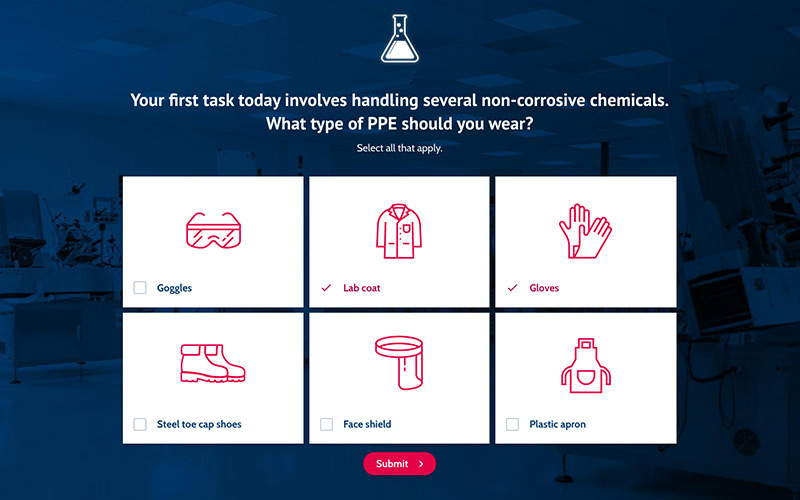
You can view this compliance training example in our Showcase page.
Why it works
- Question pools mean that when a learner retakes the test, they’re unlikely to see the same questions again. This helps ensure learners truly understand the content – they won’t be able to simply choose a different answer on a second attempt. It also makes it harder for learners to share answers as it is unlikely their colleagues will have been posed the same set of questions
- Light-touch scenarios ensure the questions are relevant – learners apply what they’ve learnt to a realistic situation, as opposed to just checking knowledge
- A range of question types are used to keep the learner engaged and avoid risking repetition
2. A test-first approach to compliance training
Businesses often need to demonstrate compliance annually. But making employees sit through the same online training courses year after year is what gives compliance training a bad rep. This example shows a different approach.
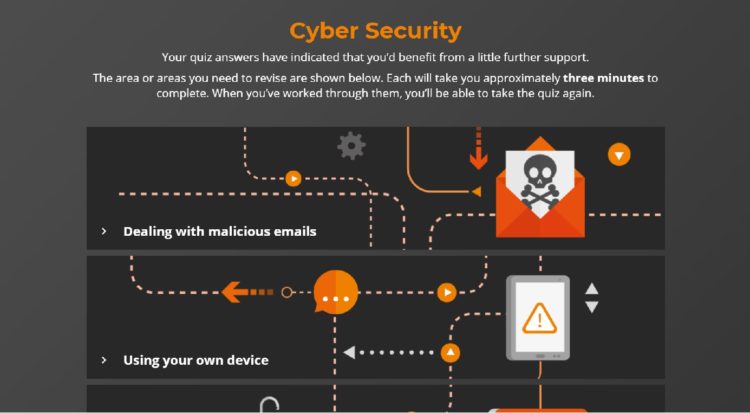
You can see this test-first compliance training example in our Showcase page
Why it works
- A “test-out” approach means nobody spends time on training they don’t need – saving time and money!
- The quiz uses a range of Elucidat question types and scenario-style questions to keep things interesting and relevant
- Testing first means users only see learning content that they actually need, and that content is kept short and focused
- From the outset, the demo is user-centric; the landing page says “protect yourself against cyber attacks”, highlighting the individual (not business) need for it
3. In-depth compliance training
Breaking down your training into short chunks goes a long way to holding learners’ attention and avoiding a situation where they click without reading. It also allows you to focus each chunk on a specific learning point or behavior, as you can see in this Cyber Security example.
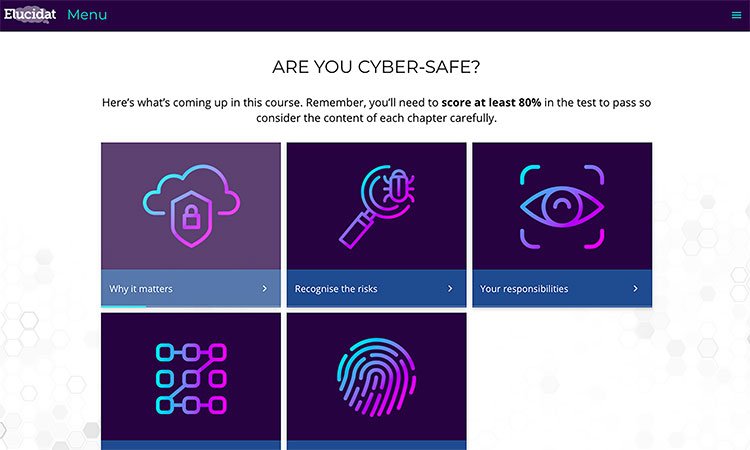
You can see this in-depth compliance training example in our Showcase page.
Why it works
- Learners can see the sections of the course at a glance and get a sense of progress as they tick off each section
- The course can be completed in multiple sessions, fitting in around a learner’s busy workday and focus levels
- Sections are practical and relevant, covering risks and responsibilities rather than legalese that’s hard to digest
- Practical, application focused activities and assessment questions are part of the learning experience, making it active not passive
4. Role-selectors and branching for personalized content
Often compliance training takes the approach of throwing the whole rulebook at everybody. This example about parental leave shows how easy it is to tailor the content to different user groups, and what a difference that makes.
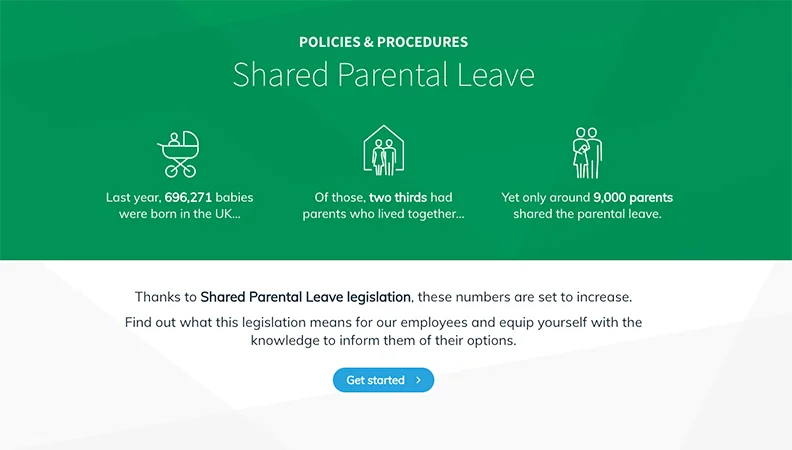
Why it works
- A simple role selector means HR professionals get all the training they need, whereas other employees only see what they need to know and do
- It keeps the branching sensibly simple: in this case, HR or not-HR is sufficient, rather than tailored paths for multiple job roles
- This approach means you can create one course on a hefty policy or procedure, but let different groups access different subsets – a big user impact without content duplication
- A dynamic menu makes the branching feel seamless as, in this example, there’s no need for the user to be aware of alternative routes through the content
- The whole demo is focused on real-life application of the content, both in terms of level of detail needed and in the decisions and tasks replicated in the simple, practical quiz
5. Step-by-step compliance process
When learners need to get to grips with a practical compliance process it’s important to make it as simple to digest as possible. This example shows how you can use a visual menu to break up the steps of a process without losing sight of the bigger picture.
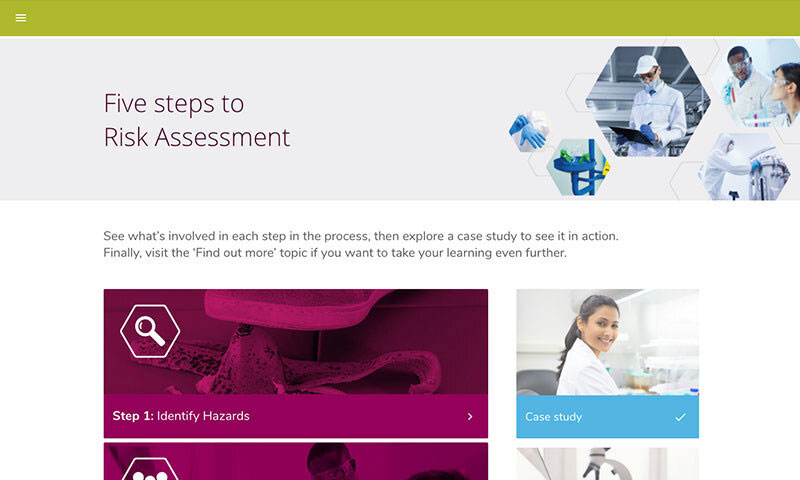
You can see this step-by-step compliance training example in our Showcase page.
Why it works
- This visual menu presents each step as a separate topic, stacked in the order of the process. Learners get an overview of the process at a glance, helping them see the bigger picture before they select a topic to get the detail.
- The topic design can be flexed to suit how complex the process is. In this example each topic uses a single interaction to provide a quick overview of the step – making it easy to double up the course as a refresher module too. You can also expand this approach for more complicated processes by adding multiple pages to a topic.
- A final case study supports the steps, demonstrating how the process can be used in real life, alongside a summary of where to go to find out more.
Those were just a few examples of how you can meet compliance requirements or tackle policies and procedures in a way that engages users.
Dig deeper into compliance training best practice
If you are looking to up your business compliance training game even further we have several resources you need to check out:
- Why and how to create compliance training stragegy that drives behavior change
- Elearning best practice guide
- How to choose the best online training tool for your organization
- Top tips to rethink your compliance training program (podcast)
Want to shake up your approach to compliance training?
Not sure where to start? Elucidat is here to help.
Elucidat’s Template feature offers a series of templates tailored to help you meet your project goals. We’ve designed a series of compliance-specific templates to support authors, giving you the confidence to try out new, best practice approaches to structuring your training. From branching scenarios and case studies to in-depth explorations, there’s a template available to help you create best-in-class online compliance training.
Inspired by these compliance training examples and want to improve your own elearning course? Get a free trial of Elucidat and see what you can do.




